Chinese handicrafts: dough figurines
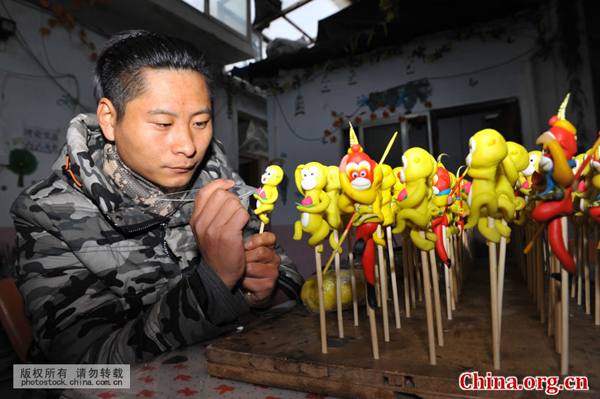 |
|
Dough figurine artist Li Jinguo works with great care in Donggang District, Rizhao City in Shandong Province, on Jan. 6, 2016. His latest work – a hundred monkeys welcome the Chinese New Year – took him more than one month to design, two weeks to mold and five kilograms of flour. The dough figurines come in a great variety of shapes and postures. [Photo by Liu Mingzhao/China.com.cn] |
Editor's note:
Dough figurine molding is a traditional Chinese folk art. It is a kind of small sculpture that uses flour and glutinous rice flour as the main raw materials. Components such as color, paraffin and honey are added and the sculpture undergoes crack control and mildew-proof processing. In the process of molding the dough figurines, craftsmen knead, twine, rub and lift the colored dough, and then use small scissors, bamboo knives and small combs among other tools to cut, carve, draw and mold the small figurines. After decorated with hair and clothes, various artistic images are created, including graceful and elegant beauties, lovely children, historical figures, living creatures and characters. The following pictures tell the story of a dough figurine artist from Shandong Province and his latest works for China's forthcoming Year of the Monkey. More >>
Huzhou calligraphy brush a national treasure
 |
|
The Huzhou calligraphy brush has always been known as an important element of the "four treasures in the study" along with Anhui ink, the Duan ink stone, and Xuan paper in Chinese culture. Produced in Shanlian Town, Huzhou City of Zhejiang Province, it is one of the most recognizable Chinese brushes used for calligraphy. [Photo by Wang Chuan/China.com.cn] |
Editor's note:
"Hubi" stands for the Huzhou calligraphy brush, which has always been known as an important element of the "four treasures in the study" along with Anhui ink, the Duan ink stone and Xuan paper in Chinese culture. The Huzhou brush produced in Shanlian Town, Huzhou City of Zhejiang Province, is one of the most recognizable Chinese brushes used for calligraphy. Historians traced the development of the Huzhou brush back to the Qin Dynasty (221-206 BC). For more than 2,000 years, the Huzhou brushes have been favored by calligraphers throughout China for their excellence in workmanship and variety of styles. Moreover, they have been exported to numerous countries and regions in the world. With business becoming more transparent nowadays, tourists can have a closer observation and thus a better understanding of its production line. More >>
Tiger-head shoes and caps for kids
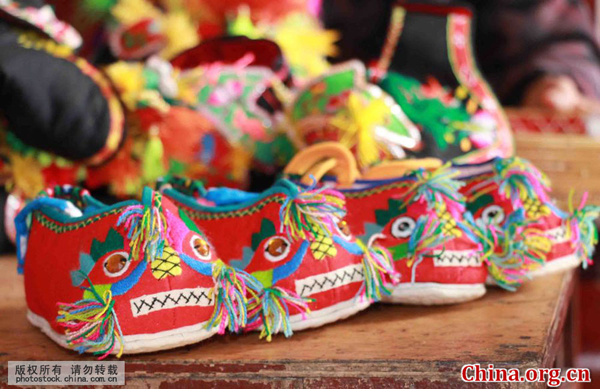 |
|
These are tiger-head shoes made by 97-year-old Jiang Weishi. She displays the tiger-head shoes and caps for her neighbor Xu Qiaoxia and her children in Weizhuang Village of Woyang County in Anhui Province, on Nov. 26, 2015. It is a skill handed down in her family from generation to generation. Jiang started to learn the skill at the age of 15 and her products have been well received by local people. [Photo by Gao Yanan/China.com.cn] |
Editor's note:
Tiger-head shoes and caps are traditional Chinese folk handicrafts used as clothing accessories for children. In Chinese culture, tigers are regarded as auspicious and vigorous. It’s customary to decorate the upper and fore parts of shoes and caps with vivid images of tiger-head patterns in the hope that their children will become as robust and healthy as tigers. Great care and precision is needed to make the handcrafts including sewing, stitching and embroidering. Materials are usually colorful cotton fabrics and threads. Tiger-head caps and shoes have a huge market particularly during the cold winter and the New Year period. In the following pictures, two senior craftswomen from Anhui Province display their products of excellent workmanship. More >>
Xun, an ancient folk musical instrument
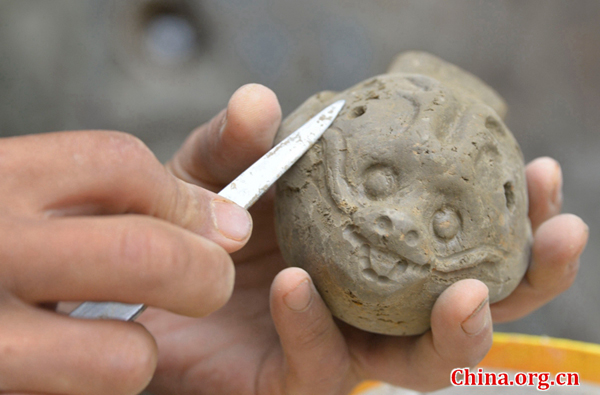 |
|
Chen Yuanzhong carves a Xun, an ancient Chinese wind instrument, at his residential area in Zunyi, Guizhou Province, on Aug. 14, 2015. [Photo by Luo Xinghan/China.com.cn] |
Editor's note:
The Xun is an ancient Chinese wind instrument with a history of approximately 7,000 years. It is made of porcelain, with one to six holes, and is shaped like an egg. Chen Yuanzhong, aged 59, lives in Zunyi, southwest China's Guizhou Province. He has practiced carving Xun for more than 40 years. The musical instruments made by him are uniquely shaped and distinctly melodious. As a result, while making this folk handicraft product, he has had a new lease on life and found favor with both the local people and tourists. Currently, Chen has been included into local brilliant talents' database. More >>
Chinese handcraft: hair embroidery
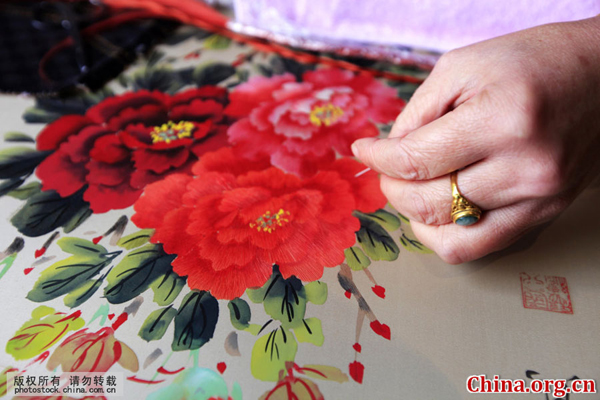 |
|
A woman works on a piece of hair embroidery on Dec. 5, 2015. Originating from Dongtai, located in Yancheng City of Jiangsu Province, more than 1,300 years ago, hair embroidery is one of the gems of ancient Chinese embroidery art, hailed as a "unique skill of the world." [Photo by Han Jiajun/China.com.cn] |
Editor's note:
Hair embroidery is one of the gems of ancient Chinese embroidery art hailed as a "unique skill of the world." As the name indicates, it refers to a style of embroidery which uses human hair as a thread instead of other materials. According to historical records, hair embroidery originated in Dongtai, Jiangsu Province, more than 1,300 years ago. Usually, hair embroidery requires more time and painstaking efforts to complete than other kinds of embroidery because more precision and higher techniques are needed. Hair embroidery's designs are vivid and varied, involving living creatures, plants, landscapes and historical figures. Presently, the art has been included into the provincial-level intangible cultural heritage list. More >>
Cooper inherits traditional handicraft
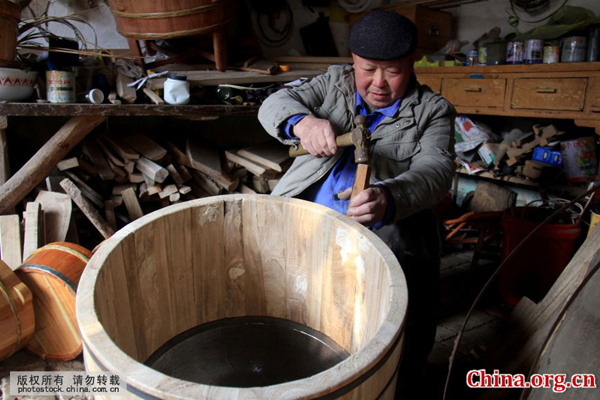 |
|
Xu Jizhong works on wooden bucket at his home in Lianyungang, Jiangsu Province, on Jan. 2, 2016. Xu is presently the only inheritor of this traditional skill in the city. [Photo by Shao Shixin/China.com.cn] |
Editor's note:
Wooden buckets are still commonly used for bathing, cooking, and washing clothes in China. However, most craftsmen making the products have gone out of business as they have already been replaced by modern production lines. Xu Jizhong, aged 60, a man in Lianyungang, Jiangsu Province, is among the few coopers who still produce wooden buckets by using traditional tools and techniques. Having first started to learn the skill at the age of 12, Xu is presently the only inheritor of this traditional skill in the city. His products are stout and durable, different in shape and style, and of excellent workmanship. Moreover, the technique has been included into the municipal-level intangible cultural heritage list. More >>
Straw plaiting, countryman's unique skill
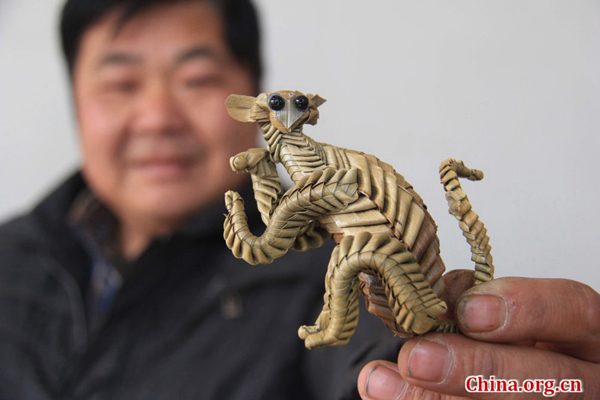 |
|
Tang Yunlun displays a monkey straw-plaited handicraft at his home in Gaoling Village of Lianyungang City in Jiangsu Province on Dec. 28, 2015. [Photo by Shao Shixin/China.com.cn] |
Editor's note:
Tang Yunlun, 50, lives in Gaoling Village of Lianyungang City in Jiangsu Province. He is famed for his unique style of straw plaiting which has been handed down in his family from generation to generation. Tang began to learn the skill at the age of five. He specializes in plaiting flowers, birds, fish and insects with the raw materials of straws, bean skins and artificial leaves. His products are vivid and of excellent workmanship. They have even been sold overseas to South Korea. As the Year of the Monkey approaches, according to the Chinese lunar calendar, Tang has made a series of lovely monkey handicrafts for the occasion. More >>
Monkeys on artist's gourd pyrography
 |
|
A tourist displays a pair of gourd pyrography handicrafts decorated with zodiac monkeys created by Wang Lanqi, a folk artist in Suzhou, Jiangsu Province, on Dec. 29, 2015. [Photo by Wang Jiankang/China.com.cn] |
Editor's note:
Gourd phrography is a traditional Chinese handicraft. As the Year of the Monkey is drawing nearer, according to the Chinese lunar calendar, handicrafts related with the zodiac monkeys have become particularly popular throughout the country. Wang Lanqi, a gourd pyrography artist in Suzhou, Jiangsu Province, has recently created a group of zodiac monkey handicrafts using the high-temperature electric ironing. His works have a distinctive style and are well received by both local people and tourists. More >>
Inkstone carver passes on traditional skill
 |
|
Jiang Lianggen works on inkstone carving at his workshop in Zhongping Village, Wuyuan County of Jiangxi Province, Dec. 27, 2015. The area has been selected as a State-level productive protection demonstration base for intangible cultural heritage. [Photo by Zhuo Weizhong/China.com.cn] |
Editor's notes:
Inkstone carving is traditional Chinese craftsmanship playing an important role in the inheritance of an ancient civilization and traditional Chinese culture. Jiang Lianggen, 42, a farmer from a village of Wuyuan County, Jiangxi Province, has been engaged in inkstone carving since 1990 when he graduated from high school. Through painstaking effort, he has made obvious progress in knowledge and skill, winning many awards including the title of a "National Intangible Cultural Successor." The workshop Jiang built up in 1999 has now developed into an inkstone manufacturing base of some scale and he now has quite a lot of apprentices working under him. More >>
Young chef and his eggshell carving
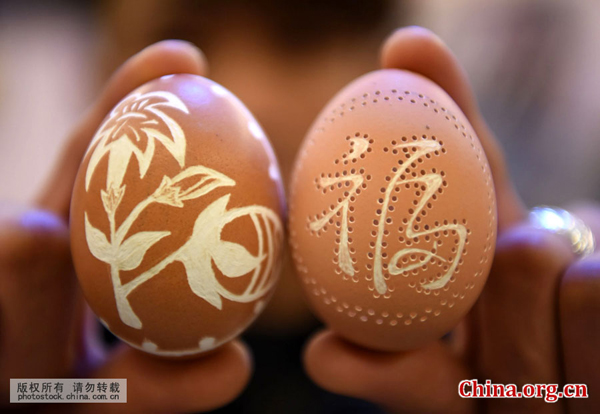 |
|
He Ya displays eggshell carving works which he made at his home in Bozhou, Anhui Province on Dec. 16, 2015. [Photo by Liu Qinli/china.com.cn] |
Editor's note:
It is amazing that something as fragile as an empty eggshell can be made into an elegant work of art. These beautiful eggshell carving works were made by He Ya, a 28-year-old chef working at a restaurant in Bozhou, Anhui Province. He began to take a deep interest in eggshell carving five years ago and has been working hard to improve his professional skills. His works are particularly favored by local young people as every cut and touch is so exquisite, flexible and vivid, with the contents covering a wide range of flowers, grasses, Chinese characters and hollowed-out patterns. More >>
Guomenjian, a good sign for New Year
 |
|
Villager Shi Longjiang makes Guomenjian at his home in Yanzhuang Town, Juxian County of Shandong Province, on Jan. 7, 2016. Guomenjian are red or colorful paper cuts, with auspicious signs and characters, pasted by Chinese people over the doors or windows of their homes to welcome the traditional festivals like the Chinese New Year. [Photo by Chen Weifeng/photostock.china.com.cn] |
Editor's note:
Guomenjian, also called menqian'er, are red or colorful paper cuts with auspicious signs and characters, pasted by Chinese people over the doors or windows of their homes to welcome the traditional festivals like the Spring Festival. Juxian County in Shandong Province has a history of more than one hundred years producing this traditional folk craft. Many families in the area make a living by making and processing the products. The traditional production method starts by cutting a stack of paper into sheets according to the required sizes, then putting a template on the paper sheets and fixing them together. Finally, they are placed on a wax plate to be carved. This handicraft produced in the area has been included into UNESCO's Representative List of the Intangible Cultural Heritage of Humanity. In the following pictures, a local craftsman displays his unique skill and final works for the upcoming Chinese New Year. More >>
Fluffing cotton, a disappearing handicraft
 |
|
Peng Chengzhi uses a bamboo stick to fluff a pile of cotton spread out on his working table in Zhangye Village of Shuangfeng County in Hunan Province on Jan. 10, 2016. [Photo by Li Jianxin/China.com.cn] |
Editor's note: Fluffing cotton is a traditional handicraft in China, even though it is rarely seen in both urban and rural areas now. It used to be a very popular industry where workers fluffed cotton with bowstrings and turned a pile of cotton into a quilt. Nowadays, many quilts are made of synthetic fibers, silk or feather down and are sold in supermarkets. With highly-efficient machine production completely taking over manual fluffing, this folk handicraft has been gradually lost and is probably gone forever. Peng Zhicheng, a 69-year-old man from Shuangfeng County, Hunan Province, has been engaged in cotton fluffing for more than 50 years. He is probably the last generation who will inherit this traditional handicraft. In the following pictures, Peng displays his unique cotton-fluffing skills. More >>